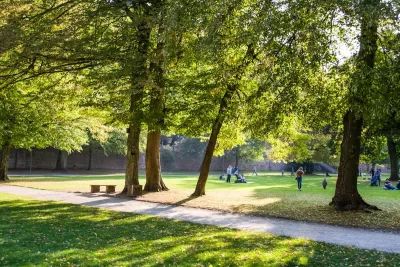The study reveals significant gaps in urban forestry, emphasizing the urgent need for reforms, innovative planting solutions, and expanded tree canopy to combat climate change and improve urban health.

The “3+30+300 rule,” a benchmark for greener cities introduced by urban forestry expert Professor Cecil Konijnendijk, sets standards for tree visibility, canopy cover, and park accessibility to enhance health, mitigate climate change, and create heat-resilient urban environments.
As reported by Thami Croeser, a study applying the rule to eight cities—Melbourne, Sydney, New York, Denver, Seattle, Buenos Aires, Amsterdam, and Singapore—revealed significant gaps in urban forestry infrastructure, with Singapore as the only city to pass all three criteria. Challenges include inadequate tree canopy coverage, insufficient access to parks, and issues like sparse planting and small tree sizes that limit shade and cooling benefits, even in cities renowned for their green initiatives.
Urban forests face structural challenges such as compacted soils, impermeable surfaces, and aggressive pruning practices that hinder tree growth and longevity. Sparse planting and restrictive engineering standards exacerbate these issues, making it difficult for cities to meet the benchmarks of the 3+30+300 rule. For example, while many buildings in Melbourne and Sydney have views of three trees, few achieve sufficient neighborhood canopy cover. Cities like Nice, France, face similar contradictions, with visible trees often being too small or too spread out to provide meaningful shade or ecological benefits.
To address these deficiencies, reforms are needed to prioritize trees as critical infrastructure alongside innovative planting solutions like soil vaults and permeable paving. These strategies not only enhance tree growth and longevity but also reduce urban flooding and improve environmental resilience. The study underscores the urgent need for cities worldwide to expand and protect urban forests, particularly as climate change intensifies and urban populations grow, emphasizing that comprehensive green infrastructure is essential for sustainable, livable cities.
FULL STORY: We rated the urban forests of 8 global cities – only Singapore passed the 30% canopy test

Alabama: Trump Terminates Settlements for Black Communities Harmed By Raw Sewage
Trump deemed the landmark civil rights agreement “illegal DEI and environmental justice policy.”

Planetizen Federal Action Tracker
A weekly monitor of how Trump’s orders and actions are impacting planners and planning in America.

Why Should We Subsidize Public Transportation?
Many public transit agencies face financial stress due to rising costs, declining fare revenue, and declining subsidies. Transit advocates must provide a strong business case for increasing public transit funding.

Understanding Road Diets
An explainer from Momentum highlights the advantages of reducing vehicle lanes in favor of more bike, transit, and pedestrian infrastructure.

New California Law Regulates Warehouse Pollution
A new law tightens building and emissions regulations for large distribution warehouses to mitigate air pollution and traffic in surrounding communities.

Phoenix Announces Opening Date for Light Rail Extension
The South Central extension will connect South Phoenix to downtown and other major hubs starting on June 7.
Urban Design for Planners 1: Software Tools
This six-course series explores essential urban design concepts using open source software and equips planners with the tools they need to participate fully in the urban design process.
Planning for Universal Design
Learn the tools for implementing Universal Design in planning regulations.
Caltrans
Smith Gee Studio
Institute for Housing and Urban Development Studies (IHS)
City of Grandview
Harvard GSD Executive Education
Toledo-Lucas County Plan Commissions
Salt Lake City
NYU Wagner Graduate School of Public Service





























